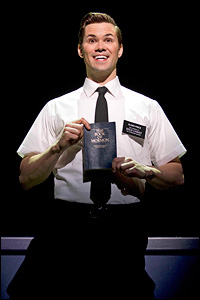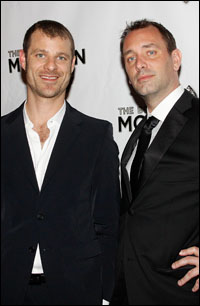
*
After hoofing it as a dancer in the Broadway dance spectacles Crazy for You, Steel Pier and Thoroughly Modern Millie, Tony Award nominee Casey Nicholaw stepped out of the chorus and has become one of Broadway's most sought-after director-choreographers. He earned his first Tony Award nomination for his Broadway debut as a choreographer on the musical Monty Python's Spamalot and followed it up as both director and choreographer on another Tony-winning crowd-pleaser The Drowsy Chaperone, for which he earned Tony nominations in Direction and Choreography categories.
His success as director and choreographer continued with the City Center Encores! productions of Follies and Anyone Can Whistle, as well as the stage musical adaptation of the holiday film comedy Elf, which arrived on Broadway in late 2010 for a Christmas run. His next project is a two-act production of Disney's Aladdin at the 5th Avenue Theatre in Seattle in July.
Nicholaw's work on The Book of Mormon, Broadway's latest hot ticket from the creators of "South Park" and Avenue Q, has garnered the prolific showman two more Tony Award nominations in the Best Direction (shared with Mormon co-author Trey Parker) and Best Choreography categories.
* How do you come up with a unique dance vocabulary for a musical? What influenced you, particularly for The Book of Mormon?
Casey Nicholaw: It really depends on what kind of show you're doing. I think that's what's fun and exciting about The Book of Mormon, they all get to look and play with each other on stage. It's different and more fun than everyone just backing someone up.
| |
 |
|
| Andrew Rannells in Book of Mormon. | ||
| photo by Joan Marcus |
As we started expanding the show and our work began evolving, that physical vocabulary began creeping into the show even more, especially because Trey was like, "We need more of the 'Two By Two' stuff!" So, it sort of became the dance vocabulary for the Mormon boys and by the time we got to "Tomorrow Is a Latter Day," which wasn't originally conceived this way, we now have the African ensemble coming together and doing that same choreography. I think that's fun for the audience to see.
You've also worked on musicals where the dance is set within a particular time period, like The Drowsy Chaperone and Follies. Do you do a great deal of research?
CN: Drowsy was really a valentine to that era of Broadway and vaudeville really, so I did all kinds of research. The thing with research is that you can get an idea of it, but then you have to make it your own. If you're just "authentic," that's all it is,but it's not necessarily theatrical. Something that was racy in 1920 is not racy now, or doesn't look like any kind of movement at all. So, you sort of have to take the idea of it and make it fresh for now. I had to bring my own vocabulary to it.
How much of your work is fully mapped out before you enter the rehearsal room and how much do you rely on your cast to help forge the physicality?
CN: It's much stronger if you base your choreography around the person who's doing it, rather than to just give them steps that will look good on you. I certainly am completely prepared when I walk into rehearsals, but I'm also prepared to throw it out if it doesn't work or it doesn't look good on someone. Or even if an actor says, "Wouldn't it be funny if we did this?" I'll say, "Yeah," and we'll change it.
You want it to evolve that way. That's the fun of theatre and the fun of choreography, I think. With Drowsy Chaperone, those roles were not fully formed until we got those people involved. And then you say, "OK, let's work toward Beth Leavel's strengths, and Georgia Engel's strengths and Eddie Korbich and everybody who was involved."
| |
 |
|
| Robert Lopez and Casey Nicholaw | ||
| photo by Joseph Marzullo/WENN |
CN: I get a feel for the arc of the show. I get a sense of what feels right with the flow. I'll read a script over and over with a pen and just circle everything. Things that feel wrong, or things that I have an idea about. I'll just keep doing that over and over. Then after a couple passes, I'll talk with the book writer and we'll work a little bit. We'll just keep passing through it and we'll amend it until it feels like a good starting place.
Do you seek out high points in the text, or the potential for strong dance moments?
CN: I really want my work to serve the story more than anything. I don't go looking for moments where I can put some flash in here or there, it's never on my mind. But when we go into dance pre-production, I'll usually hire four dancers to help, and then I start seeing the real physical build of it, about where it goes and try to put it together that way. That's where I get most inspired. I think dance pre-production is my absolute favorite time of putting a musical together, because that's when the numbers really start coming to life.
Was it a seamless transition to go from strictly choreographing to doing double duty as a director?
CN: It's pretty seamless, because beforehand I know where the numbers are leading to. So, I'm prepared to build the scenes to lead us into the songs smoothly. I think that the role of the director-choreographer should be seamless in that way. It's a musical, so the numbers are the touchstones of the story, so you need to be sure that the scenes build into those numbers well and that the transitions out of that number also work seamlessly.
Also, I'm a good collaborator. I have really good associates. Jen Warner and John MacInnis are my associates on Mormon and we all work as a team. I don't just hire people who are just gonna get coffee, or something. We work well together and we've known each other for years, so they can say stuff and I can honestly ask, "Do you like that?" and they can tell me yes, or no.
Another big collaboration that most audience members aren't aware of is that of the choreographer and the dance arranger. How do you work together?
CN: Exactly. Glen Kelly, who did all the dance arrangements for The Book of Mormon is really a genius. People underestimate that role. He did the dance arrangements for Spamalot and Drowsy Chaperone and he's just spectacular. It's inspiring to hear his music. I tell him what I want feeling-wise and then he goes and writes something, and I go "Oh my God!" and then that inspires me. Then I might say "I need more time here, or more flash here, or it doesn't quite build well enough here," and then we'll work to come up with what the feel of the number and the arc of the number's gonna be like.
| |
 |
|
| Matt Stone and Trey Parker | ||
| photo by Joseph Marzullo/WENN |
CN: Well, it comes from my love for musical theatre. Of course, when I look at a script, I recognize that a moment has the potential to be a huge number. Or you need a huge number at this point in the show. Or, we've got four ballads together and this slot has to be bigger, or incorporate more than three people. So it's a balancing act sometimes in how that moment comes about, as far as the structure of it all goes.
But with a dance number in particular, I usually start in the middle. Usually with the central dance section to sort of learn the vocabulary and then I build to that, because that's usually easier. I always save the end for last, because the hardest thing is how do you end something if you love the middle? The ending is always intimidating to me. And also, not just intimidating, but I never want it to end. I always love working so much that I don't always want to put a button on it.
You have a strong tap background from shows like Crazy for You and Millie. You also use it for a great moment in The Book of Mormon. Were you a tapper growing up?
CN: I grew up as a tapper. That was my strongest point as a dancer. I certainly don't have a lot of flexibility, and I was never drawn to ballet, as much as I love jumping around, I just never looked pretty doing it. Also, I love tapping in shows. I'd love to do a show that was just a tap show, which would be a blast. That's always my favorite thing.
Any particular dance step that you can rely on to get a crowd on their feet for a big dance show stopper?
CN: Well, everyone loves a time step! But also, everyone's seen everything so much. You can't do a kick line anymore and have people go crazy for it. You just can't. You have to build them up emotionally to get to a spot. I think people are numb to a kick line at the end. Which is always kind of a hassle, because you think it's going to get that response, but it doesn't anymore!











